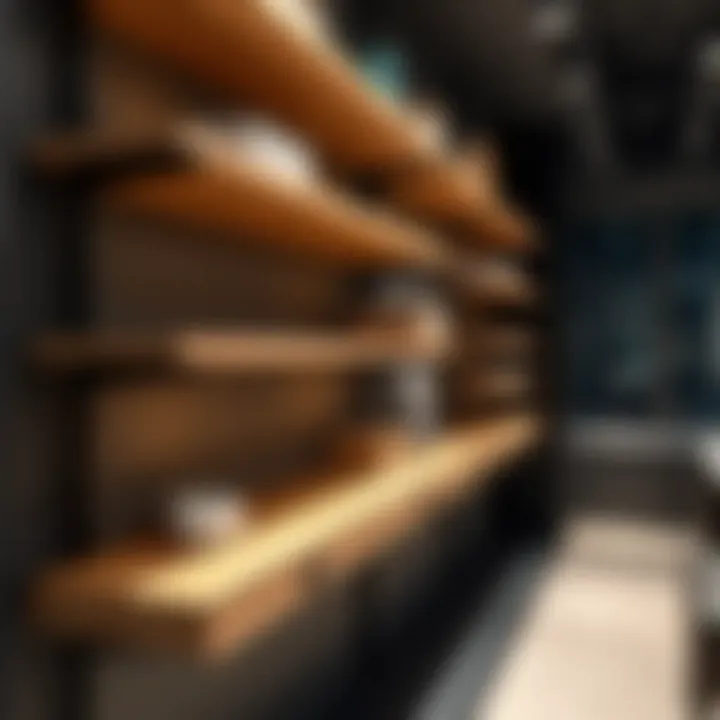Shelf Track Systems and Mounting Brackets Explained


Intro
In today’s world of interior design, shelf track systems and brackets play an essential role in achieving both functionality and visual appeal. The significant flexibility these systems provide is hard to overlook, especially for avid organizers or the occasional DIYers looking to personalize their space. In essence, a well-designed shelf track system can convert a dreary corner into a showcase, maximizing every inch without sacrificing style.
When it comes down to brass tacks, understanding the intricacies of these components can be the difference between a cluttered mess and a streamlined haven. This guide will walk you through various aspects of shelf track systems, including current design trends, practical buying tips, and installation insights.
For homeowners and designers, the right shelving can dictate not only storage solutions but also the overall feel of a room. Beyond that, retailers and enthusiasts can glean a wealth of knowledge regarding product quality and value. As we dive into the details, you will find that choosing the right configurations will enrich the aesthetic and practical utility of your unseen space.
Intro to Shelf Track Systems
Shelf track systems offer a versatile and innovative approach to organizing space. These systems, which consist of tracks mounted to walls and supporting brackets for shelving, provide an efficient way to customize storage solutions. Homeowners, designers, retailers, and DIY enthusiasts alike can benefit from their functional versatility and adaptability. Understanding shelf track systems is essential for anyone looking to maximize their space's potential and aesthetics.
When discussing shelf track systems, it’s important to recognize how they allow for easy adjustments and changes without the fuss of traditional shelving. With a wide variety of configurations available, users can add, remove, or alter shelf heights according to their specific storage needs. For instance, those looking to create a more open space in a living room can easily rearrange or reconfigure their shelves to suit their style and practical requirements.
Some benefits of adopting a shelf track system include:
- Flexibility: Users can modify shelf heights with ease, allowing shelves to accommodate items of different sizes—from books and decor to kitchen supplies.
- Space Optimization: These systems can be installed in various settings where traditional shelving would struggle, such as small rooms or unique angles.
- Installation Simplicity: Compared to building custom cabinetry, shelf tracks can be set up in a jiffy, often requiring minimal tools.
It’s worth noting the considerations that come with shelf track systems. The choice of materials, load-bearing capacity, and aesthetic appeal all play critical roles in deciding the right system for your space. Additionally, the proper installation and maintenance practices can ensure that both functionality and looks are preserved over time.
"The first step in organizing is understanding your space and determining how best to utilize it. Shelf track systems are one of the best ways to do just that."
In summary, the importance of shelf track systems lies in their blend of practical organization and style enhancement, making them a relevant topic for those with a keen interest in interior design and utility. Whether you’re looking for a DIY solution or a professional-grade installation, understanding the components and benefits of shelf track systems is a crucial starting point.
Components of Shelf Track Systems
Shelf track systems are pivotal in modern space management, bridging the gap between functionality and aesthetic appeal. Understanding the components that make up these systems is essential for both installation and effective use. Each element serves a unique purpose, contributing to the overall efficiency and adaptability of shelving solutions in residential and commercial environments.
Shelf Tracks
At the heart of any shelf track system lies the shelf track itself. These are typically long strips, often made of heavy-duty metal or durable plastic, affixed to walls. Think of shelf tracks as the backbone of your shelving configuration. Their primary role is to provide the necessary support for the brackets and ultimately the shelves.
When choosing shelf tracks, consider the weight capacity that they can support, which can vary significantly based on the material and design. For instance, a metal track designed for heavy-duty application will usually accommodate much more weight than a basic plastic counterpart. Furthermore, the installation height can be adjusted, allowing for a customizable layout that caters to both aesthetics and practicality.
"The beauty of shelf tracks is their ability to adapt to your changing needs, whether it's adding new shelves or rearranging your setup to better fit your evolving storage requirements."
Brackets
Next up, we have the brackets, those seemingly simple yet remarkably effective components. Brackets come in various styles such as L-brackets or more decorative options, providing the necessary support structure for the shelves themselves. The choice of brackets can greatly influence the overall look of your shelving system.
When selecting brackets, pay attention to how they complement your shelf track and chosen materials. Some brackets are engineered to be adjustable, making it possible to shift shelves without the hassle of extensive reinstallation. For instance, if a homeowner decides to switch from books to decorative boxes, adjustable brackets allow for a simple revision without starting from scratch.
It’s worth noting that the material of the brackets too plays a significant role in durability and weight capacity. Metal brackets offer robust support, while wooden brackets can add a rustic charm to the arrangement.
Shelving Materials
The types of shelving materials you choose can make or break your shelving system. Options abound: from traditional wood to modern metal, each material brings with it different aesthetic and functional qualities. Wood offers warmth and a classic feel, suitable for home libraries or cozy kitchens. Metal shelves, on the other hand, may suit a contemporary office space, creating a sleek, minimalist appearance.
When selecting shelving material, consider not only weight and aesthetics, but also your intended use. For example, glass shelves might be ideal for decorative displays but could lack the sturdiness needed for heavy book storage.
In short, the combination of shelf tracks, brackets, and shelving materials forms the foundation of an effective and stunning shelf track system. By thoughtfully considering each component, you can create a space that meets your functional needs while looking fabulous.
Types of Shelf Tracks
When it comes to maximizing storage and organization, understanding the different types of shelf tracks available on the market is paramount. Shelf tracks are the backbone of a shelving system, providing versatile options to fit various needs and spaces. By choosing the right type of shelf track, you can greatly enhance both functionality and aesthetics. Let's take a closer look at three prominent types: standard shelf tracks, heavy-duty options, and adjustable shelf tracks.
Standard Shelf Tracks
Standard shelf tracks are the go-to choice for many homeowners and retailers alike. These tracks are typically made from a durable material, providing reliable support for basic shelving needs. They are usually installed on walls or inside cabinets, featuring a straightforward design that allows for easy installation.
The ease of use cannot be overstated:
- Quick Setup: Standard shelf tracks come with pre-drilled holes which simplify mounting. You often don't need specialized tools.
- Versatile Use: They’re perfect in various settings—living rooms for books, kitchens for plates, or even workshops for tools.
- Cost-Effective: These tracks are generally less expensive, making them accessible for budget-conscious DIYers.
Moreover, they often come in various finishes, enabling homeowners to tailor their choice to the overall decor. This means you don’t just get functionality; you also get an aesthetic that aligns with your space.
Heavy-Duty Options
For those with heavier storage needs, heavy-duty shelf tracks step up to the plate. Designed to hold substantial weight without compromising stability, these tracks are essential in environments like commercial spaces or garages where tools, equipment, or bulky items are stored.
Key features include:
- Robust Materials: Usually constructed from high-grade steel or reinforced metals, heavy-duty tracks withstand intense pressure.
- Lengthier Span: They can extend over larger areas, allowing for broader shelving arrangements without intermediary supports.
- Safer Design: With an emphasis on load-bearing capabilities, these tracks usually include secure mounting options to prevent accidents.
Thus, if you’re looking to store heavy books or industrial supplies, investing in heavy-duty options is a no-brainer. Not only do they make your storage space functional, but they also provide peace of mind when dealing with precious or dangerous items.
Adjustable Shelf Tracks
Adjustable shelf tracks shine in versatility, catering well to changing storage needs. Designed with flexibility in mind, these tracks allow consumers to modify shelf heights without much hassle. This adaptability is particularly valuable in spaces that evolve—like children's rooms or rapidly changing retail displays.
Advantages you might appreciate include:


- Customizable Heights: Users can easily reposition shelves for items of varying sizes.
- Future-Proofing: As your storage needs change, these tracks can adjust accordingly, reducing the need for complete overhauls.
- Enhanced Management: They permit better organization; for instance, you can neatly arrange books on one shelf and toys on another without needing separate units.
Types of Brackets
Understanding the different types of brackets available for shelf track systems is essential for effective shelving solutions. These brackets not only support the weight of the shelves, but also contribute to the overall aesthetics of your space. Choosing the right bracket is akin to selecting the perfect pair of shoes for an outfit; it can make or break functionality and style. Let’s explore the principal types of brackets with clarity and detail.
L-Brackets
L-brackets are one of the most common types used in various shelving applications. These brackets are characterized by their L-shaped design, making them robust and versatile. Their primary role is to support shelves from below, providing a stable foundation. Here are a few points to consider about L-brackets:
- Sturdiness: Their design allows them to bear heavy loads without warping, making them suitable for both light and heavy shelving.
- Simplicity in Installation: Usually requiring less effort to install compared to some more elaborate bracket types, many DIYers find L-brackets easier to work with.
- Affordability: They often come in various materials including steel, aluminum, and plastic, typically at budget-friendly prices.
While L-brackets perform wonderfully in a variety of settings, it's crucial to ensure they match the weight capacity required for your specific shelving needs. Testing the weight limits ahead of time will save headaches later on.
Bracket Designs for Aesthetics
Not all brackets are created equal, especially when it comes to aesthetics. The visual appeal of a bracket can greatly enhance or detract from a room’s design. Options abound, offering plenty of design choices:
- Geometric Designs: Modern and minimalist, these brackets are often made of metal and adopt sharp angles, creating a striking look that fits well with contemporary interiors.
- Rustic Wood Designs: Perfect for farmhouse-style decor, wooden brackets add warmth and a natural touch. They can range from rough-hewn to polished finishes, depending on the desired end look.
- Creative Shapes: Some designers offer brackets shaped like trees, arrows, or other artistic forms. These can serve as functional art pieces, allowing your shelving to be both utilitarian and an expression of personal taste.
Consideration of style is vital because brackets are not just functional; they are often highly visible parts of the overall shelving system.
Selecting the right bracket needs a thoughtful approach that considers both function and style. A well-chosen bracket can truly tie a room together, just as a good piece of furniture does.
By keeping the aspects of both L-brackets and decorative options in mind, you ensure that your choice aligns with the practical needs and aesthetics of your space. As always, measuring shelf weight and considering personal design preferences will lead to a more satisfying shelving experience.
Benefits of Shelf Track Systems
Shelf track systems offer a multitude of advantages that make them a preferable choice for both residential and commercial applications. Understanding these benefits can assist homeowners and designers in making informed decisions. Below are several key aspects that highlight the worth of incorporating such systems into various settings.
Flexibility and Adaptability
One of the most significant advantages of shelf track systems is their inherent flexibility. Unlike traditional shelving, these systems can easily be adjusted to meet changing needs. This is ideal in environments where items frequently change, like a retail space. For example, if a store decides to introduce a new product line, the shelves can be repositioned without needing to dismantle the entire setup.
Moreover, this adaptability caters to different types of shelving materials, whether they are wood, metal, or glass. By simply altering the heights of the brackets, the same shelf track can accommodate a wide range of items, from books and decorative items to heavy machinery, responding to varying weight demands seamlessly.
Ease of Installation
Installing shelf track systems requires minimal tools and can often be completed without professional assistance. Homeowners and DIY enthusiasts can complete the setup in a matter of hours, rather than days. The assembly process typically involves securing the track to the wall using screws, followed by attaching the brackets. The intuitive design simplifies even the most complex of installations.
Perhaps the easiest way to illustrate this point is with a step-by-step approach. Here’s a simplified process:
- Choose the location: Select an area that would benefit from shelving, such as a laundry room or garage.
- Mark the wall: Use a level and pencil to mark the vertical lines for the tracks.
- Attach the tracks: Drill the appropriate holes and secure the tracks.
- Insert brackets: Once tracks are secure, attach brackets at the desired heights.
- Place shelves: Finally, position the shelves on the brackets.
This simple process allows users to create a functional storage area tailored to their specific needs without requiring an extensive skillset.
Maximizing Space Efficiency
Space efficiency is crucial in any environment, especially in homes and commercial spaces where square footage may be limited. Shelf track systems help to optimize the use of vertical space, allowing for more effective organization.
Consider, for instance, a home with limited closet space. With shelf track systems, the walls can be transformed into multi-functional storage areas. By utilizing the full vertical height of a room, one can place shelving at various heights to store items ranging from seasonal clothing to everyday essentials. This maximization of space can drastically reduce clutter.
Moreover, in commercial settings, this efficient use of space can lead directly to increased productivity. Properly organized spaces foster a better workflow. When items are easily accessible, the time spent searching for products or tools decreases significantly. This improvement not only saves time but also enhances the overall experience, be it for employees or customers.
"Using shelf track systems is like unlocking an extra room worth of storage without even having to move a wall."
Installation Process
The importance of the installation process in setting up shelf track systems cannot be overstated. This entire endeavor can either make or break the effectiveness and aesthetic appeal of your shelving solutions. When done well, installation not only ensures maximal space utilization but also enhances the overall functionality of the shelves you’ve chosen. Getting it right from the beginning means fewer headaches down the line, especially in troubleshooting or adjustments.
Preparation and Planning
Before diving into installation, laying the groundwork is essential. You wouldn’t build a house without a blueprint, and the same holds true for shelf track systems.
- Measure Twice, Cut Once: Start with precise measurements of the wall space where the shelf track will go. Use a level to ensure your markings are straight. Misaligned tracks can lead to everything being off-kilter—size matters.
- Selecting the Right Wall Material: Know what your wall is made of. Drywall? Concrete? Each material demands different tools and techniques. For heavier loads, finding wall studs can make all the difference.
- Gathering Tools and Materials: Before beginning, collect everything you'll need:
- Confirm the Load Capacity: Understand the weight limits of your selected system. Too much weight on your shelves can risk collapse.
- Drill
- Level
- Tape measure
- Appropriate screws and anchors
- The shelf tracks and brackets themselves
Step-by-Step Installation
Once you’ve prepped and planned, it’s time to roll up your sleeves. Here’s how to install the shelf track in a straightforward, step-by-step method:
- Mark the Installation Points: Begin by marking where the top of the shelf track will go. Use a pencil for visibility—I can’t stress enough the importance of accuracy in this step.
- Align and Fix the Track: Position the shelf track against the wall at the marked points. Once you're satisfied it's aligned, pre-drill your holes for easier installation.
- Secure the Shelf Track: Fasten the shelf track into place with screws, ensuring that it is fully anchored. It’s crucial that everything is flush against the wall.
- Add Brackets: Install brackets at regular intervals along the track. The number of brackets needed often depends on the weight of the items you plan to store. Keep in mind: more isn’t always better, but adequate support is vital.
- Install the Shelves: Finally, slide your shelves into place on the installed brackets. Test each shelf by applying pressure gently—if everything feels solid, you’re good to go!
Troubleshooting Common Issues
Even the best-laid plans can hit snags. When problems arise, it’s good to know how to tackle them efficiently:
- Uneven Shelves: If your shelves appear to sag or tilt, double-check that the shelf tracks are level. A quick adjustment may be all that’s needed.
- Brackets Not Supporting Weight: Something hasn’t gone right if your brackets bend under load. Assess whether the installation was anchored correctly, and consider adding more brackets or adjusting their placement.
- Difficulty Adjusting Shelf Height: If you find it tricky to alter shelf heights after installation, use the right size brackets and tracks designed for your specific shelving system. Some solutions have limited flexibility if installed incorrectly.
Remember: Taking your time, following directions closely, and ensuring everything is level will save you a heap of trouble in the future. Don’t rush—patience pays off.


With these steps and tips, you’re now well-equipped to tackle the installation of your shelf track systems with confidence. Ultimately, a well-done installation not only enhances functionality but also the visual appeal of your space.
Maintenance Considerations
Proper upkeep is pivotal for any shelf track system, ensuring longevity and optimal performance. When systems are not maintained, they can become less effective and even hazardous. Addressing maintenance considerations means being proactive rather than reactive.
Regular Inspections
Regular inspections are akin to a routine health check-up for your shelf track systems. Taking the time to assess the components can help identify any potential issues before they escalate into more serious problems.
- Inspect the tracks and brackets regularly for any signs of wear and tear. Look for rust, bending, or loosening that could compromise structural integrity.
- Check the load-bearing capacity often. Every bracket has a specified weight limit, and exceeding this can lead to failure.
- Alignment matters. Ensure that all shelves remain level and are properly aligned. A tilted shelf can lead to an accidental spilling of items, creating chaos and potential safety hazards.
"A stitch in time saves nine," as the saying goes; catching small issues before they blow up can save you a heap of trouble.
Establishing a routine inspection schedule—ideally every few months—can help ensure your shelves are functioning safely and effectively. Whether you have a shelf track system in your home office or your retail space, consistent checks keep your setup running smoothly.
Cleaning and Care
Cleaning and care go hand-in-hand with regular maintenance. It's not just about aesthetics; proper cleaning helps maintain the functionality of the shelf track systems.
- Dust and debris can accumulate, particularly in hard-to-reach areas. Use a soft cloth or a vacuum with a brush attachment to gently remove dust from tracks and brackets.
- Avoid harsh chemicals. A mild detergent mixed with water often does the trick. Avoid anything that could corrode the materials of your shelf track system.
- Inspect the shelving materials during cleaning. If you notice any signs of damage like chips or cracks in wooden shelves or degradation in metal ones, it might be time to replace them.
- Moisture control is crucial, especially for materials susceptible to warping or rust. Ensure the area around your shelves is well-ventilated to minimize humidity effects.
Being diligent about cleaning not only prolongs the life of your fixtures but also contributes to a more organized and pleasing space.
Aesthetic Appeal of Shelf Track Systems
When it comes to interior design, the adage "form follows function" often rings true. However, in the realm of shelf track systems, aesthetic appeal is more than just a pleasing visual. It stands at the intersection of style and utility, influencing the way spaces feel and function. The trend of open shelving has fueled demand for systems that not only serve a practical purpose but also complement, or even enhance, the decor of a room. Here, we will explore the varied design options available, along with how thoughtful incorporation of colors and finishes can spruce up any environment.
Design Options
Choosing the right design for shelf track systems doesn't merely come down to functionality; it greatly impacts how an area is perceived. There are several styles available that cater to varying tastes and preferences:
- Minimalist Designs: Sleek and unobtrusive, these designs focus on clean lines and simplicity, often using metal tracks and brackets that blend seamlessly into their surroundings. They’re perfect for contemporary spaces where clutter-free aesthetics are desired.
- Rustic Charm: With wood materials and iron brackets, rustic designs can transform a space into a cozy haven. This type of shelf track system often pairs well with textures like brick or reclaimed wood, adding warmth and character.
- Industrial Touches: For those who appreciate a modern, edgy vibe, industrial-style shelf track systems utilize materials like steel and concrete. The raw finishes highlight authenticity, making them a great fit for loft apartments or urban homes.
The choice of design will be dictated not only by personal taste but also by the intended functionality of the shelves. For instance, a heavily trafficked area might benefit from something sturdy and straightforward, while a showcase area can afford to be more decorative.
Incorporating Colors and Finishes
Color can dramatically alter the ambiance of a space. When selecting colors and finishes for shelf track systems, here are some key elements to consider:
- Color Trends: Opt for popular colors that resonate with your overall design. Soft pastels can create an airy feel, whereas bold shades, like navy blue or forest green, add a touch of drama.
- Contrasting Finishes: Mixing finishes can lead to striking visual impacts. For example, matte brackets against a shiny track can create depth. Experimenting with contrasting elements can breathe life into the arrangement and make a statement.
- Natural Material Effects: Achieving finishes that mimic natural materials can elevate the aesthetic further. Wood-grain textures or stone finishes could appeal to nature lovers and enhance organic design schemes.
- Branding and Personal Touch: For commercial spaces, brand colors can also be incorporated into the shelf track designs, aligning them with overall branding strategies and enhancing identity.
In a nutshell, ensuring the aesthetic appeal of shelf track systems leads not only to enhanced visual interest but contributes to the functionality and emotional atmosphere of a space. When design choices are made thoughtfully, they resonate with users and transforms ordinary spaces into visually engaging environments.
Common Applications
Understanding the common applications of shelf track systems is crucial for homeowners, designers, and DIYers alike. These systems are not just about holding items; they're about maximizing efficiency and adaptability in various spaces. Whether it’s a cozy living room or a bustling retail environment, each application has its own unique requirements and benefits, making the choice of a shelf track and bracket system particularly significant.
Residential Use
Living Rooms
The living room is often the heart of the home, a place where family and friends gather. Utilizing shelf track systems here allows for a highly customizable arrangement for books, photos, or décor items. One key characteristic of using shelf tracks in living rooms is flexibility. Homeowners can easily change the height of shelves or rearrange the layout without dealing with major installation headaches. This adaptability makes it a popular choice, as it caters to evolving tastes or design needs over time.
Also, these systems can harmonize with various interior styles, from rustic to modern. A unique feature of shelf tracks in living rooms is their subtle ability to enhance the overall aesthetics of the space. Well-placed shelves can draw the eye upward, creating an illusion of height and spaciousness.
However, there could be disadvantages. In smaller living spaces, bulky shelf systems might feel overwhelming. Homeowners need to balance the visual impact of their shelving against the size of the room.
Kitchens
In the kitchen, shelf track systems serve a dual purpose: functionality and organization. The importance of being able to adapt to the cooking habits and storage needs of a family cannot be overstated. Typically, these systems allow for easy access to cooking utensils, spices, and pantry items, all organized neatly on adjustable shelves.
The key characteristic here is efficiency. With the fast-paced life that revolves around meal preparations, having a well-organized shelving system can save significant time. A specific positive feature is how open shelving can encourage better visibility and accessibility of items, making cooking and cleanup more manageable.
On the flip side, open shelves may lead to aesthetic clutter if not organized properly. Dust accumulation on exposed items might also be a concern, requiring more frequent cleaning to maintain the visual appeal.
Home Offices
A home office must balance productivity and style, and shelf track systems play a pivotal role in achieving this. With remote work becoming the norm for many, maximizing space is a top priority. Here, the flexibility of shelf tracks allows individuals to adjust the height and layout according to personal needs and preferences.
The key characteristic of this setting is organization. Having dedicated shelves for books, documents, and office supplies helps to keep the work environment tidy and promotes efficiency. A unique feature of home offices is the ability to create a personalized workspace that reflects the individual’s taste while remaining practical.
However, a downside might be the risk of overloading shelves with materials, leading to potential safety issues or disorganization. It's crucial to assess the load-bearing capacity of shelves to avoid problems.
Commercial Use
Retail Spaces
In retail settings, shelf track systems are vital for presenting products effectively while maximizing sales floor space. The versatile nature of these systems allows retailers to adapt displays quickly based on inventory changes or promotional events. One key characteristic here is visual merchandising. Well-placed shelves can draw customers in and enhance their shopping experience.
The unique feature in this case is the ability for easy reconfiguration. Retailers can swap out displays during seasonal promotions or change branding strategies without a significant investment in new fixtures. This adaptability translates directly into more agile business strategies.


However, the disadvantage might lie in durability. Retail environments often experience high traffic, and if inexpensive materials are used, they may wear out quickly.
Workplaces
In workplaces, shelf track systems contribute heavily to increasing productivity. A well-organized space can help employees find resources efficiently, reducing time spent searching and improving workflow. The key characteristic of workplace applications is the emphasis on practicality and accessibility.
A feature worthy of mention is the ability to customize the system for different departments or purposes, be it for holding files or displaying awards and recognitions. This brings a sense of professionalism and organization to any office.
Yet, similar to retail spaces, maintaining the structural integrity of these systems under heavy load is a continual consideration. Companies must be vigilant about keeping track of what weight their shelf systems can handle.
Comparative Analysis of Shelf Track Systems and Traditional Shelving
Understanding the comparative nuances between shelf track systems and traditional shelving is central to making informed decisions in home organization, design, and commercial settings. Each method offers distinct advantages and drawbacks, impacting how efficiently one can utilize shelf space. This section delves into the factors that set these two options apart, enabling homeowners, designers, retailers, and DIYers to select the optimal solution for their specific needs.
Cost Efficiency
When it comes to cost, the first thought that pops into one’s mind is always budget. Shelf track systems often stand out as a more economical choice in the long run. Here’s the breakdown:
- Initial Investment: While the upfront costs for shelf tracks can seem higher than traditional shelving due to the necessity of tracks, brackets, and shelving materials, they provide a flexibility that can lead to substantial savings.
- Long-term Usability: The adjustable nature of shelf tracks permits easy modification of shelving height and placement. This means as your storage needs change, you won’t have to shell out more cash for new units, unlike traditional shelving where the layout is more fixed.
- Durability: Most shelf track systems are built from sturdy materials designed to withstand considerable weight. If you accidentally miscalculate the load and a conventional shelf buckles, it might often mean extra costs replacing shelves and perhaps damaged items.
This versatility and durability = really pays off!
Functional Differences
Functional differences between shelf track systems and traditional shelving can be a game-changer when considering usage:
- Adaptability: Shelf track systems allow users to easily reposition shelves as needed. Need that upper shelf to hold seasonal decorations? It takes just a few minutes to adjust it lower. In contrast, adjusting traditional shelving requires dismantling and potentially damaging your wall space.
- Installation: Installing shelf track systems might require a bit more effort initially to set up the tracks and ensure they are level. Once that’s in place, adjustments can be made swiftly without hassle.
- Weight Distribution: With brackets that are specifically designed for various weight loads, shelf tracks can accommodate heavier items effortlessly. Traditional shelving may sag or become unstable if overloaded, potentially leading to a dangerous mess.
The right shelving system can completely change your space. A well-planned setup prevents clutter and even emotional stress.
Environmental Considerations
When delving into the world of shelf track systems and brackets, it’s crucial to consider the environmental impact of the materials and practices involved. In this day and age, with increased awareness about sustainability, understanding how your shelving solutions can fit into a greener lifestyle becomes not just a choice, but a responsibility. The environmental considerations outlined here are essential for anyone looking to balance functionality with ecological integrity.
Sustainable Materials
The choice of materials plays an enormous role in how environmentally friendly your shelf track system can be. Many manufacturers are now producing shelving components made from sustainable resources. For instance, bamboo has gained traction as a material due to its rapid growth cycle and natural strength. Unlike traditional wood that may require extensive logging, bamboo can grow up to three feet a day, making it an excellent choice for eco-conscious consumers.
In addition to bamboo, recycled metals and plastics are also worth considering. These materials not only reduce the demand for virgin resources but also minimize waste. Imagine a shelf track made from aluminum sourced from old cans; it’s lightweight, durable, and a step in the right direction for reducing your carbon footprint. Companies that are committed to sustainability often highlight their eco-friendly materials on their websites, making it easier for buyers to make informed decisions.
Recycling Old Systems
Another critical aspect of environmental considerations is how to deal with old or unused shelving systems. Instead of tossing them in a landfill, consider recycling or repurposing whenever possible. Many materials from old shelf tracks and brackets can be reclaimed and transformed into new products. For example, metal can be melted down and reused, while wood can be refurbished into new furniture pieces or décor items.
"Recycling old systems not only helps in waste reduction but also contributes to resource conservation and promotes a sustainable circular economy."
To facilitate recycling, some local waste disposal services and recycling centers accept specific materials from shelving units. Collaborating with these services can keep your discarded components from cluttering landfills and igniting more environmental concerns. Furthermore, many community organizations accept old shelving for donation, which can then provide others with affordable or even free solutions for their storage needs.
Future Trends in Shelf Track Systems
As the nature of home and office environments continues to evolve, so do the systems designed to enhance functionality and aesthetics. This section explores significant innovations in shelf track systems, which not only respond to contemporary design needs but also cater to the functional demands of an increasingly diversified lifestyle. The trends here showcase shifts towards smarter, more efficient, and more sustainable solutions.
Innovative Materials
When it comes to shelf track systems, the materials used are crucial in determining their load-bearing capabilities, durability, and visual appeal. Recent years have brought forward some exciting developments in this area:
- Composite Materials: A mixture of wood fibers and resins, these materials offer the beauty of natural wood with enhanced strength and moisture resistance. Perfect for humid environments like kitchens, they are lightweight but sturdy, making them popular among DIY enthusiasts.
- Aluminum Alloys: Lighter than traditional steel, aluminum alloys are making waves for their rust resistance and ease of installation. They can be designed in various finishes, allowing customization to fit existing decor seamlessly.
- Recycled Materials: Eco-conscious homeowners are increasingly seeking solutions that lessen their carbon footprint. Many brands now provide options made from recycled plastics or metals, aligning with the sustainable ethos of modern design.
Consider the following factors when selecting materials:
- Weight Capacity: Ensure the materials can handle your storage needs while staying visually appealing.
- Finishing Options: The choice of finishes can dramatically alter the aesthetic feel of your space, blending functionality with style.
- Environmental Impact: Opt for sustainable materials not only benefits the environment but can also enhance your property's value.
"Choosing sustainable materials can transform a storage system into an eco-friendly statement piece."
Smart Shelving Solutions
Technology has seeped into every aspect of modern living, and shelving systems are no exception. Responding to the demand for convenience and efficiency, smart shelving solutions are becoming a game changer:
- Automated Adjustability: Some cutting-edge shelving systems come equipped with adjustable heights that can be modified with a remote or a smartphone app. This allows users to change their shelving layout easily, adapting to changing needs without the hassle of manual installation.
- Integrated Lighting: Imagine shelves that light up when you open the cabinet door. Smart shelves are being designed with built-in LED lighting to ensure visibility and add ambiance, turning a simple storage solution into a visually striking feature.
- Inventory Tracking: In web-driven homes, inventory management systems can now connect to your shelves. Using sensors, these systems track items placed on shelves and alert users when it’s time to restock, ideal for kitchens or workshops.
Finale
The conclusion of this guide serves as a vital juncture for Homeowners, Designers, Retailers, Enthusiasts, and DIYers to reflect on the multifaceted benefits of shelf track systems and brackets. Throughout this article, we unpacked the nitty-gritty surrounding these essential organizational tools and highlighted their practical applications in everyday spaces. Understanding how to effectively use, install, and maintain these systems is not just about aesthetic appeal but also about maximizing functionality and efficiency.
Recap of Key Points
To wrap things up, let’s revisit the critical takeaways:
- Definition and Purpose: Shelf track systems offer an adaptable framework that can accommodate various shelving needs. They allow for flexibility in positioning shelves according to the changing requirements of your space.
- Types of Components: We discussed several components, including various shelf tracks and brackets that provide structural support and customization options.
- Installation Process: A step-by-step approach was outlined for a smooth setup experience, highlighting that proper planning and troubleshooting can mitigate common issues.
- Maintenance: Regular inspections and care can ensure longevity and reliability of your shelving systems, making them a wise investment in any environment.
- Aesthetic and Functional Integration: The ability to incorporate unique designs and finishes enhances the visual appeal while still serving essential organizational roles.
- Sustainability Considerations: We explored sustainable materials and recycling options that contribute positively to the environment, marrying functionality with eco-friendliness.
“In the world of shelving, a sturdy track system is the unsung hero, fostering both organization and creativity.”
Encouraging Exploration
As you close this guide, consider the myriad opportunities available for personalizing your shelf track systems to fit your needs. By experimenting with different styles, finishes, and configurations, you can create a shelving solution that seamlessly blends into your home or commercial setting.
Take time to explore innovative products and ideas through communities, forums, and social media dedicated to home improvement and interior design. Platforms like reddit.com/r/HomeImprovement offer a treasure trove of insights from fellow DIYers and professionals who share their experiences and designs.
Don’t hesitate to dive into the world of shelving systems—your next organizational project awaits you, and the right tools, creativity, and knowledge can turn your vision into reality.















